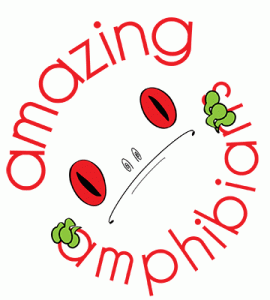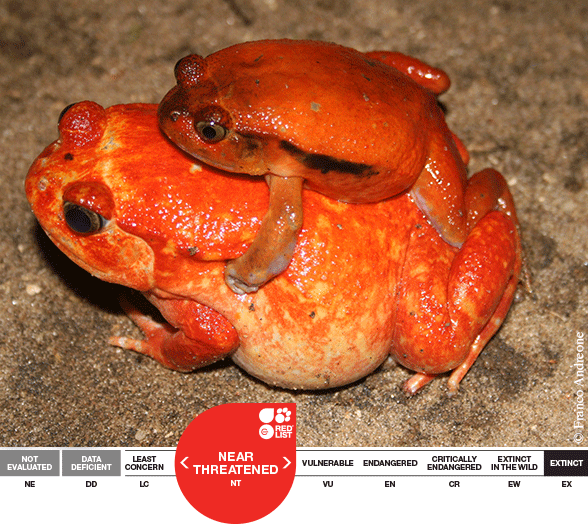 The Tomato Frog, Dyscophus antongilii is a conspicuous red-orange frog belonging to the Microhylidae family. In Maroantsetra it has almost continuous activity all around the year. It lays the eggs mainly in the warmer periods (October-January), and they are dispersed on the water surface after an amplexus of several hours. The typical calls emitted by males gives the onomatopoetic name of saogongogno attributed by local populations to this species. It is present in eastern and northeastern Madagascar, with two main nuclei, one around and within the town of Maroantsetra, and the other in the surroundings of Antara, close to the town of Toamasina. It is a species adapted to live in quite open spaces, usually in marshes and still-water channels. It does not occur within rainforests, although it needs humid sites. Like other representative of the family it is terrestrial and fossorial, and is mainly active during rainfalls. It is assessed as ‘Near Threatened’ by the IUCN Red List of Threatened SpeciesTM.
The Tomato Frog, Dyscophus antongilii is a conspicuous red-orange frog belonging to the Microhylidae family. In Maroantsetra it has almost continuous activity all around the year. It lays the eggs mainly in the warmer periods (October-January), and they are dispersed on the water surface after an amplexus of several hours. The typical calls emitted by males gives the onomatopoetic name of saogongogno attributed by local populations to this species. It is present in eastern and northeastern Madagascar, with two main nuclei, one around and within the town of Maroantsetra, and the other in the surroundings of Antara, close to the town of Toamasina. It is a species adapted to live in quite open spaces, usually in marshes and still-water channels. It does not occur within rainforests, although it needs humid sites. Like other representative of the family it is terrestrial and fossorial, and is mainly active during rainfalls. It is assessed as ‘Near Threatened’ by the IUCN Red List of Threatened SpeciesTM.
 |
The Tomato Frog is suffering from the alteration of its original habitats. Once common in Maroantsetra, it appears to become rarer due to the growing urbanisation. Until the end of the Eighties of last century the species was actively searched for the international pet trade, and for this reason it was included in CITES Appendix I. Nowadays its capture and commerce are forbidden.
Current conservation actions include the realisation of a dedicated breeding habitat within Maroantsetra. Named “Tomato Frog Village” it protects one of the most prominent populations living in this town, and gives opportunity to local children of looking at one of the most attractive and known frogs of Madagascar. More conservation actions are still badly needed, especially to protect the species urban population of Maroantsetra, and include some of the other populations in the network of protected areas.
Submit your observations of this species to iNaturalist and they will appear on this map. Learn more about this species on Amphibiaweb.
More Amazing Amphibians here.
Produced in partnership with:
Senior Partners |
|||
 |
 |
 |
|
 |
|||
Focal Partners |
|
 |
|
Affiliates |
|||
 |
 |
||
 |
|||
How to become an Amazing Amphibians partner:
Outlined below are the roles and responsibilities for the 4 different levels of involvement for potential partners. If your organization would like to be a part of the Amazing Amphibians program in either of these capacities please email amazing@amphibians.org.
Senior Partner – These partners will help with multiple aspects of the program, help facilitate the completion of several species profiles, publicize each Amazing Amphibian and will likely have a landing page for the program on their website. This level of partner will be leading in using their communication channels to gather additional information for the program such as images and data points for iNaturalist.
Strategic Partner – These partners will play an active role in creating species profiles, submitting at least three species profiles per year and actively use their social network to publicize each Amazing Amphibian. This level of partner will be active in using their communication channels to gather additional information for the program such as images and data points for iNaturalist.
Focal Partner – Partners tend to be active in a limited geographic area. This partner will submit at least one regional species profile per year and use their social network to publicize each Amazing Amphibian. This level of partner will be involved in using their communication channels to gather additional information at a regional level for the program such as images and data points for iNaturalist.
Affiliate – These partners are interested in promoting the program but might not be in a position to provide profiles. These partners will publicize each Amazing Amphibian through the social media outlets.







